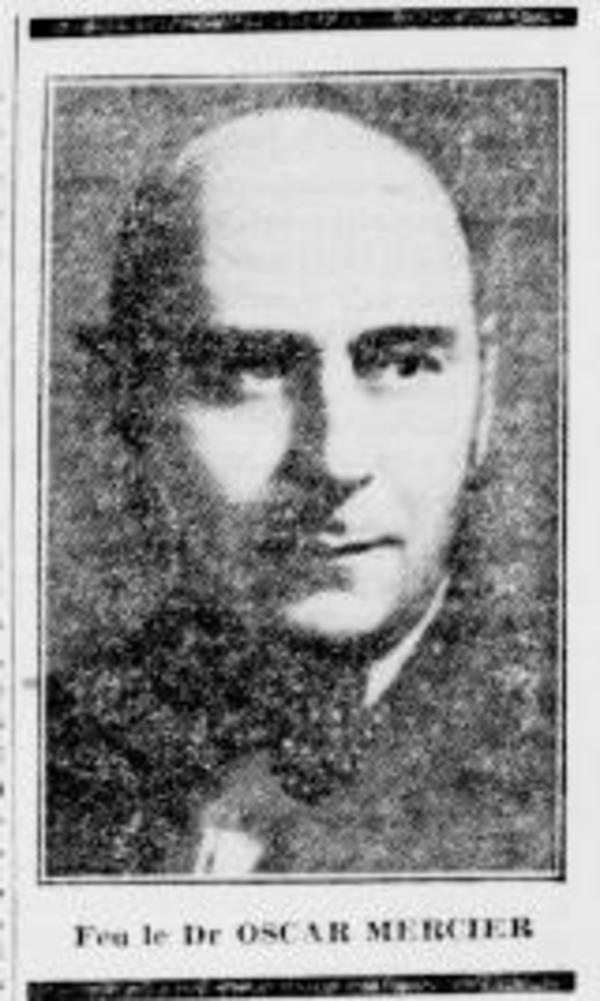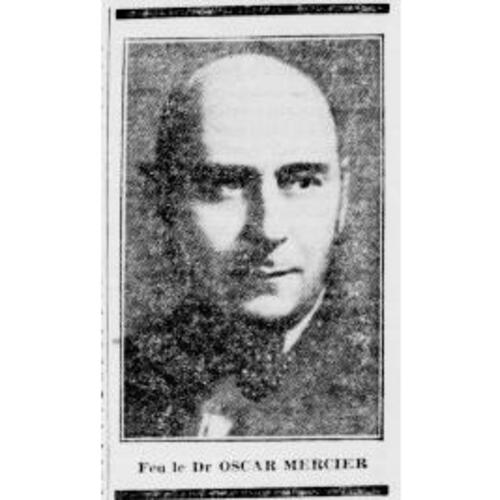
Source: Link
MERCIER, OSCAR-FÉLIX, physician, surgeon, professor, and hospital administrator; b. 1 Dec. 1866 in Montreal, son of Joseph Mercier, a carter, and Zoé Gauthier; m. there 4 June 1895 Alexina Rolland, and they had one son and two daughters; d. there 26 July 1929.
After primary schooling at the École Modèle Jacques-Cartier in Montreal, Oscar-Félix Mercier went on to obtain his classical education at the Petit Séminaire de Montréal, where he enrolled in 1879, and then at the Collège Sainte-Marie. A brilliant and disciplined pupil, he took up the study of medicine at the Université Laval in Montreal in 1886. He obtained his md in 1890 and was licensed to practise by the College of Physicians and Surgeons of the Province of Quebec on 14 May that year. Soon after, he went to Paris for further training as a surgeon. For two years he attended the clinic of Dr Paul Reclus, where he was introduced to the antiseptic and aseptic techniques recommended by French surgeons Octave Terrillon and Louis-Félix Terrier, who were pioneers in aseptic surgical methods. He became aware of the efficacy of autoclaves in sterilizing water, instruments, and surgical dressings. He also learned the new techniques of local anaesthesia, including the use of cocaine.
On his return to Montreal in 1892, Mercier went to work at Notre-Dame Hospital as assistant surgeon to Dr Alfred-T. Brosseau. He continued in this capacity until 1899, when he became acting chief of surgery at the hospital, replacing Brosseau. His position was made permanent the following year. The contrast between master and assistant was striking. A gruff and withdrawn man at the end of his career, Brosseau operated using traditional procedures that combined dexterity with quick motions. A young and inquisitive surgeon interested in medical bacteriology and new techniques, Mercier favoured closely linking laboratory sciences and medicine. Despite the sometimes sharp tensions between the two, Mercier was able to obtain from the authorities at Notre-Dame Hospital the support he needed to introduce new surgical procedures.
Mercier was one of the pioneers in the introduction of aseptic methods into surgery. He used the most recent discoveries in general and local anaesthesia and operated on patients according to a strict protocol. On visits to Paris in 1896, 1920, and 1924, he learned about the rapid development of bacteriology. In the fall of 1896, for example, he enrolled in a course in “microbial technique” [see Arthur Bernier] taught by Émile Roux and Élie Metchnikoff (who would be awarded the Nobel Prize for medicine in 1908) in the laboratories of the Institut Pasteur. He was introduced at that time to research on the suppuration of wounds, including the role played by staphylococci and streptococci in post-operative infections. He also became aware of the first data obtained through immunology, such as the processes of virulence and phagocytosis. Mercier brought back from Paris various procedures for disinfection by physical means (boiling water, dry heat, moist heat, and steam sterilizers) and by chemical means (various antiseptics). In short, he was one of the first Canadian surgeons to receive adequate theoretical and practical training in microbial techniques as applied to surgery. With his rigorous method of surgical asepsis, he successfully performed abdominal operations, including herniotomies and appendectomies, which until then had been very dangerous.
After Mercier became chief of surgery in 1899, the reforms already introduced were consolidated and surgical practice was modernized at an accelerated pace. Under his leadership, extremely stringent measures of asepsis and tight controls on anaesthesia were put into effect. In addition, operating schedules and access to the operating room became stricter, the teaching of pathology there was forbidden, the staff received appropriate training, more effective instruments were acquired, and a recovery room was installed. The operating room and its annexes also underwent significant changes with the introduction of a mechanical operating table, dressing sterilizer, autoclave, and glass trays for holding sterile probes, compresses, and dressings. In 1913 Mercier promoted the establishment of an anaesthesia department under the direction of a chief anaesthetist and his assistants that would be responsible for instituting regular examination of patients, setting rigid timetables, recommending the purchase of equipment, and applying new techniques, such as the use of nitrous oxide in addition to chloroform (from 1919). His efforts would result in a significant reduction in infections and post-operative deaths, despite an increase in risky surgical procedures.
Mercier’s interest in furthering medical science led him to promote improvements, not only in the operating room, but also in the laboratories at Notre-Dame Hospital. An excellent clinician and highly gifted diagnostician, he always emphasized the need to link clinical examination at the patient’s bed with anatomical and pathological examination, using the methods provided by technical and scientific innovations. While continuing to use the traditional procedures of questioning, auscultation, percussion, palpation, and chemical urinalysis, he adopted a series of new clinical approaches recently created by medical technology, including radioscopic examination, bacteriological examination of sputum, exploratory extractions of fluid by syringe for laboratory analysis, electric cautery, the injection of antitetanus serum, and the use of cocaine as a local anaesthetic. He had also helped promote the plan to build a new hospital. Until it was opened, Notre-Dame Hospital was located in what had been Donegana’s Hotel, near the Château Ramezay on Rue Notre-Dame. In 1901 the hospital authorities decided to erect a new structure on Rue Sherbrooke. The following year Mercier was a member of the committee responsible for supervising the building plans. Various problems delayed the project. Construction was under way when Mercier, after years of intense medical activity at the hospital, was appointed superintendent in 1918. In this capacity he made sure the work undertaken conformed to the construction standards of a modern, functional hospital. It was not until 1924 that the new $1.5 million building was opened. Mercier resigned as superintendent the following year, but he stayed on as chief of surgery for the rest of his life.
Through his teaching, his scientific papers, and his articles, Mercier assisted in a major way in disseminating the theoretical and practical implications of bacteriology in the field of surgery. Along with his work as a surgeon and administrator, he devoted considerable time to teaching. In 1893 he became an associate professor of surgery at the Montreal School of Medicine and Surgery, which was the faculty of medicine of the Université Laval in Montreal. He was appointed professor of clinical surgery in 1905 and joined the council of the faculty of medicine in 1913; he would hold both offices until the end of his life. To provide adequate theoretical and practical training for the staff who worked in the operating room, he had helped found a school for nurses at Notre-Dame Hospital in 1897 [see Élodie Mailloux]. His son, Oscar, would become an associate professor of surgery in the same faculty in 1927 and would be a prominent surgeon at Notre-Dame Hospital.
Mercier was very active in many professional associations. He contributed greatly to the revival of the Société Médicale de Montréal in 1900 and served as its president for the year 1903–4. In 1904 he directed the surgical section of the second congress of the Association des Médecins de Langue Française de l’Amérique du Nord, held in Montreal. One of the founders of the Société de Chirurgie de Montréal in 1928, he served as its first president. His skill was recognized outside Canada: admitted to membership in the American College of Surgeons, he was a corresponding member of the Société des Chirurgiens de Paris from 1910 to 1929.
Oscar-Félix Mercier played a major role in bringing modern surgery to the province of Quebec. His efforts to organize operating rooms, introduce aseptic and anaesthetic procedures, install new surgical equipment, and train operating room nurses enabled Notre-Dame Hospital to provide surgical care of a high quality for the time. He also contributed in a significant way to the teaching of surgery and anaesthesia, by introducing students to new operating methods (such as electrical cautery and local anaesthesia) and to recent theoretical ideas. In short, with the help of a few colleagues, he inspired an important movement to modernize hospital practice in the province of Quebec.
Oscar-Félix Mercier wrote many articles, most of them published in L’Union médicale du Canada (Montréal), for example: “L’anesthésie chirurgicale par la stovaine,” 35 (1906): 249–55; “À propos de quelques observations de cures radicales de hernies,” 25 (1896): 20–30; “L’art obstétrical à Paris,” 19 (1890): 626–31; “Des appendicites,” 21 (1892): 617–22; “Du traitement des grands écrasements des membres par l’embaumement,” 29 (1900): 831–43; “L’iode, antiseptique chirurgical,” 42 (1913): 138–48; and “Le mouvement chirurgical depuis le congrès de Québec,” 33 (1904): 412–24.
ANQ-M, CE601-S51, 2 déc. 1866, 4 juin 1895. Arch. de l’Hôpital Notre-Dame (Montréal), Procès-verbaux du bureau médical, 1892–1928; Rapports annuels, 1892–1928. Arch. de l’Institut Pasteur (Paris), Cours de microbie technique, MP 29048 (liste des personnes ayant suivi les cours, 1889–1970). Le Devoir, 27 juill. 1929. Canadian men and women of the time (Morgan; 1898 and 1912). College of Physicians and Surgeons of the Prov. of Que., Medical reg. (Montreal), 1897; 1911. “Le docteur Oscar Félix Mercier,” La Rev. moderne (Montréal), 10 (1929), no.9: 8. École de Médecine et de Chirurgie de Montréal, Annuaire, 1890–1919. Denis Goulet, Histoire de la faculté de médecine de l’université de Montréal, 1843–1993 (Montréal, 1993). Denis Goulet et al., Histoire de l’hôpital Notre-Dame de Montréal, 1880–1980 (Montréal, 1993). Denis Goulet et Othmar Keel, “Les hommes-relais de la bactériologie en territoire québécois et l’introduction de nouvelles pratiques diagnostiques et thérapeutiques (1890–1920),” RHAF, 46 (1992–93): 417–42. Denis Goulet et André Paradis, Trois siècles d’histoire médicale au Québec; chronologie des institutions et des pratiques (1639–1939) (Montréal, 1992). [Albert] Le Sage, “In memoriam: le professeur Oscar F. Mercier, 1867–1929,” L’Union médicale du Canada, 58 (1929): 523–28. Univ. de Montréal, Faculté de médecine, Annuaire, 1920–28.
Cite This Article
Denis Goulet and Philippe Hudon, “MERCIER, OSCAR-FÉLIX,” in Dictionary of Canadian Biography, vol. 15, University of Toronto/Université Laval, 2003–, accessed December 29, 2025, https://www.biographi.ca/en/bio/mercier_oscar_felix_15E.html.
The citation above shows the format for footnotes and endnotes according to the Chicago manual of style (16th edition). Information to be used in other citation formats:
| Permalink: | https://www.biographi.ca/en/bio/mercier_oscar_felix_15E.html |
| Author of Article: | Denis Goulet and Philippe Hudon |
| Title of Article: | MERCIER, OSCAR-FÉLIX |
| Publication Name: | Dictionary of Canadian Biography, vol. 15 |
| Publisher: | University of Toronto/Université Laval |
| Year of publication: | 2005 |
| Year of revision: | 2005 |
| Access Date: | December 29, 2025 |



